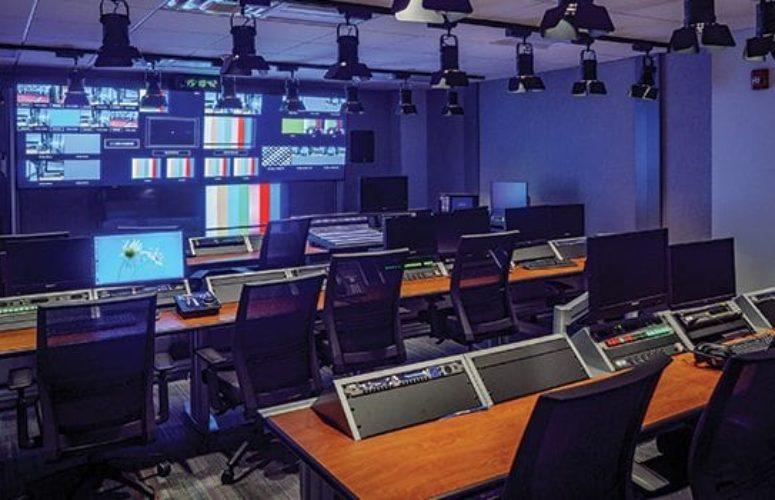
Higher Education: New Facilities and Programs
The foundation for an enriched education experience on campus.
By Jim Pytell, Assistant Editor On Oct 23, 2017While competition between universities across the country is evident, in New Jersey it feels as if there is an added emphasis on attracting and retaining students, considering the outmigration issues that the state currently faces. Higher education has an impact on all industries in varying degrees. Universities serve as a conduit in their respective states, and New Jersey is no different – with its plethora of schools: taking part in valuable partnerships with healthcare institutions; having a massive impact on local economies; and bearing tremendous responsibility in shaping the young minds of the future workforce, a workforce that will ultimately determine the future of the state.
Understanding the need to attract students while at the same time providing a recognized, quality education, New Jersey colleges are constantly striving to keep up with the demands of students, who react based on demands of current employers.
“Higher Education is a competitive field. Like all fields, we must also keep up with trends and adjust to different methods of pedagogical delivery. In turn, students understand that we deliver a quality product,” says Antonio Calcado, executive vice president for Strategic Planning and Operations and chief operating officer at Rutgers University. “The marketplace drives demand [and] we adjust to that marketplace. As an example, business today, or nursing or practically any field is not what it was 10 years ago.”
Because of this, universities are constantly innovating, building and expanding, with new facilities being one of the best ways a school can attract new students. Not only do these state-of-the-art buildings look impressive when walking on campus, but they also provide the ability to access new technologies in the classroom and allow for the utilization of new methods of teaching in today’s information age.
A perfect example of this integration of technology is Montclair State University’s new School of Communication and Media building – the most technologically advanced broadcast and media production facility at any university in the nation, which opened in September.
“Our students will gain the competitive advantage of mastering technology that not only meets industry standards, but that, in many instances, goes well beyond,” says Montclair State University College of the Arts Dean Daniel Gurskis. “This dynamic working environment is the perfect complement to a rigorous, transdisciplinary curriculum that allows students to pursue majors in communication, television and digital media, filmmaking, journalism, and public and organizational relations.”
As Gurskis points out, the building is ripe with features that mirror – and often exceed – what a student would see in many professional settings. The building includes four broadcast-ready HD and 4K studio and control rooms that boast the most extensive implementation of 4K technology at any North American university; a 197-seat presentation hall powered by Sony Digital Cinema Projection and Dolby 7.1 Surround Sound; a 40-seat screening room with the same cinema and sound features; a motion picture stage; a contemporary, broadcast ready newsroom; state-of-the-art radio control rooms; and more.
“Any student that sees this facility who is interested in this field is going to be blown away,” says Keith Strudler, School of Communication and Media director. “Part of the charge here is to create a space where people from all sectors of the journalistic enterprise can work together both in learning and producing content.”
New buildings aren’t built overnight, and nearly every university across the state has a long-term strategic plan and a vision of where it wants to position itself in the future.
“New facilities are aligned with our master plan, addressing the needs of the university as it moves forward,” Calcado says. “Technology plays a big part in how we build and is integral to whatever our plan may be. While it’s challenging to keep up with, building is a team effort.”
Rutgers University’s three campuses in New Brunswick, Newark and Camden are continuing to see significant growth as the university positions itself for the future.
In New Brunswick, a new Chemistry and Chemical Biology Building is set to open in late fall (at press time). This world-class, $115-million facility is designed to serve and train the next generation of globally engaged scientists and support the needs of the chemical industry in New Jersey and beyond. The 141,000-square-foot space on the Busch campus features flexible research laboratory areas for teaching and teaching support, classrooms and collaborative and administration space.
In Newark, opened this fall was a $59-million Life Sciences Center that will physically link existing facilities and provide opportunities for synergy among all Life Science departments. This 87,000-square-foot building will house the biology, chemistry and neuroscience departments.
The Newark campus has also seen an $11-million project on the Rutgers Business School, which represents the fit-out of 28,000 square feet of the previously unfinished second and sixth floors, including the addition of a new rear entrance to the building to accommodate the expanding business school. The space will also include two tiered lecture halls of approximately 125 seats, each with full information technology infrastructure.
Additionally, the Honors Living Learning Community (HLLC) is an $81-million project on the Newark campus that involves the creation of an innovative facility with residential and academic spaces to house nearly 400 undergraduate students, including veterans, older students, transfer students and first-generation college students. The 155,000-square-foot, five-story building will be located within the James Street Commons Historic District and will feature: academic spaces, student support functions, HLLC departmental offices, long-term bicycle storage, parking for 322 vehicles and 20,000 square feet for retail establishments. It is slated to be completed in summer 2018.
Finally, in Camden, the new Nursing and Science Building was opened this fall. The 100,000-square-foot, $62.5-million facility features teaching spaces that are consistent with the current pedagogical trends in nursing and science education, including advanced infrastructure in classrooms, specialized simulation laboratories and common space to facilitate key research and educational advancements.
Princeton University recently completed construction on the Andlinger Center for Energy and the Environment in 2016, and is celebrating the opening of the Lewis Center for the Arts this month. The facilities show an investment by the university in sustainable energy-technology development, energy efficiency, and environmental protection and remediation, in addition to creativity and the arts.
The university will also offer a certificate in entrepreneurship beginning in the current academic year, citing the importance entrepreneurship plays in driving social and economic changes that shape the future.
One of the challenges universities face when planning for the future is staying on top of the ever-changing demands of technology.
“Our recently completed Facilities Condition Assessment is a tool that identifies areas at, or that are approaching their end of useful life,” says Andrew P. Christ, PE, vice president for real estate development and capital operations at the New Jersey Institute of Technology (NJIT). “NJIT prioritizes the upgrade of these facilities through our Capital Renewal and Replacement program. During these renovations, we incorporate the latest technology into the teaching, learning, and research spaces. We then anticipate the infrastructure needs for future technological enhancements and include them in the renovation wherever possible.”
Recently completed projects at NJIT include the 200,000-square-foot Central King Building and the 24,000-square-foot Life Sciences and Engineering Center, both funded by the Building our Future Bond Act. Opening this fall is a $102-million, 209,000-square-foot Wellness and Events Center, and work is ongoing for Phase 1 of Makerspace at NJIT, an initiative that received funding as part of the 2018 state budget.
While building new facilities on campus is important, what is being taught inside is perhaps equally so.
“NJIT continuously updates the curriculum and program offerings to meet the professional career objectives of our students,” says Fadi P. Deek, provost and senior executive vice president, NJIT. “In the past few years, these additions have been primarily in the fields of computer science, biotechnology and finance/technology. At the nexus of finance and technology, our Martin Tuchman School of Management has added a PhD in business data science, in addition to an option in finance and technology in our BS in business. In the Ying Wu College of Computing, we have added an option in cyber defense as part of our MS in cybersecurity and privacy and an MS in data science. Finally, we have created an option in biotechnology as part of our MS in pharmaceutical chemistry.”
Deek says that the NJIT strategic plan addresses the need to expand the pool of highly trained STEM (Science, Technology, Engineering and Mathematics) graduates in response to the critical workforce shortage in these areas.
“Developing that workforce serves both employers and the needs of students who are increasingly mindful of the educational and fiscal commitments they make and the viability of their resulting careers,” he says. “In the past few years, interest in computing, engineering and science fields has increased significantly. Cybersecurity, biomedical and pharmaceutical fields in particular have attracted more students. Interest in analytics and finance majors has also increased. These changes reflect national and global economic trends. They also reflect increasing practicality among students.”
Monmouth University is also making efforts to invest in science education, evidenced by its new Science Building opened in September, with its final phase to be completed by the end of the fall semester.
“With our new classrooms, labs and offices, and lots of windows allowing natural light to fill the facility, our new science building has been transformative in every way,” says Dr. Steven Bachrach, dean of the School of Science at Monmouth University. “The glass hallways and walls allow students to view research and labs in action – [it’s] science on display.”
Additionally, Monmouth has also introduced a new doctor of education in educational leadership program (EdD). The new two-year, 54-credit, cohort-based doctoral program will prepare teachers, principals and superintendents for increasing levels of responsibility as they further their careers.
“This is an important program for Monmouth University and for education in New Jersey,” says Monmouth University President Grey Dimenna. “We have assembled an extraordinary faculty of practicing professionals at the superintendent level and in other leadership roles to provide our Doctor of Education candidates with the latest strategies in educational leadership.”
While many facilities improve the student experience in the classroom, Rowan University’s Rowan Boulevard development project is also providing enormous benefits to the surrounding community.
In August, the largest phase of the $400-million Rowan Boulevard development was completed, and is comprised of a unique mix of luxury student and market-rate apartments, retail and office space, state-of-the-art classrooms and a multi-level parking garage.
The entire development project is expected to have a massive economic impact on the area, and is providing a vital connection between downtown Glassboro and the Rowan campus.
“These walkways provide critical linkages throughout downtown Glassboro and will help create a safe and attractive connection between the college campus and the businesses located downtown,” says Glassboro Mayor Leo McCabe. “This is another important step in the ongoing effort to improve both the student and the consumer experience in downtown Glassboro.”
Colleges across the state will continue to grow in an effort to provide students with the best possible education available. They will stay committed to forming viable, relevant and ambitious strategic plans that will lay the groundwork for the future, and not only provide students with high quality education and experience, but also provide them with the tools to succeed in the careers that they have a genuine interest in. An investment in the next generation of students – the workforce of tomorrow – is an investment in the future of the state.
New Jersey Educational Facilities Authority is Helping Institutions Grow
The source of funding for new facilities varies, but one organization that helps New Jersey public and private colleges and universities obtain low-cost financing is the New Jersey Educational Facilities Authority (NJEFA).
It financed a record $1.35 billion in value on behalf of New Jersey’s colleges and universities, making it the nation’s third largest higher education conduit issuer in 2016. So far in 2017, the NJEFA has completed $801 million in par value of financing on behalf of five institutions. Four of these transactions had refunding components which resulted in $64 million in net present value savings. Since its inception in 1966, the authority has completed 511 transactions with a combined value of $17 billion.
Some of the work NJEFA does is issue bonds to fund grants under four other revolving state-backed bond programs that were available as part of the 2013 and 2015 Higher Education Capital Grant Program solicitation including: the Capital Improvement Fund (CIF), the Facilities Trust Fund (HEFT), the Technology Infrastructure Fund (HETI), and the Equipment Leasing Fund (ELF).
While Building Our Future Bonds are issued by the state through the State Treasurer’s Office, the NJEFA does assist the Office of the Secretary of Higher Education in the administration of these grants by assisting in the development and distribution of the grant program solicitation, intake and review of grant applications, and review of all Building Our Future requisitions for disbursement of grant funds to colleges and universities for their approved projects.
Additionally, all bonds authorized under the Building Our Future Bond Act have since been issued and grant awards have been completed by the Secretary of Higher Education and the Legislature.
The remainder of 2017 will continue to be very active with several financings in the pipeline that are expected to close by year-end. NJEFA anticipates that the total value of financings on behalf of colleges and universities in 2017 will exceed $1 billion.
Stemming the Brain Drain
Why It’s Important to Keep New Jersey’s Students Here for College.
Each year, the students who leave New Jersey to attend college in another state far outnumber the out-of-state students who attend one of New Jersey’s colleges. This net-outmigration, or “brain drain,” hurts our economy and depletes our workforce. Reversing this damaging decades-long trend requires state support, institutional resourcefulness, and business leadership.
In 2014 (the most recent statistics available), 34,782 first-time undergraduates left New Jersey, while 5,876 out-of-state students came to New Jersey to start college, for a net out-migration of 28,906 new undergraduates.
To attract students to New Jersey’s colleges with state-of-the-art facilities without increasing tuition and fees, the state must boost its capital support for our colleges, and make it more consistent. The $750-million Building Our Future Bond fund, approved by 63 percent of New Jersey’s voters in 2012, was the first general-obligation bond for higher education in 25 years. New facilities for science, engineering, nursing and business, plus expanded classrooms, were just some of the projects built with the bond proceeds. We cannot wait another 25 years for the next state-backed bond fund for higher education.
To give students a head-start on postsecondary education and introduce them to New Jersey’s institutions of higher education, our public colleges partner with local high schools through dual-enrollment programs. Dual-enrollment students earn college credit while in high school and can transfer those credits to accelerate their college degree.
The business community knows the importance of retaining New Jersey’s talent. The Georgetown Center on Education and the Workforce projects that 29 percent of New Jersey’s jobs will require a bachelor’s degree in 2020, the highest percentage of any state. NJBIA recently formed a Postsecondary Education Task Force to build and promote a dynamic brand for higher education in New Jersey, and develop strategies to prepare our future workforce. I am excited to be a member of this task force and contribute to solving New Jersey’s brain drain.
— By Michael W. Klein – Executive Director of the New Jersey Association of State Colleges and Universities
Beginning Professional Careers Closer to Home
Thirty interns take part in Smart Students Choose New Jersey.
While New Jersey colleges and universities are actively building facilities and creating programs to attract and retain students, New Jersey businesses are doing their part, too. Choose New Jersey, through its Smart Students Choose New Jersey program, is helping high-achieving students who choose to advance their education in-state begin their professional careers close to home.
Thirty New Jersey college students who graduated from high schools in Newark and Camden had the opportunity to intern at businesses and non-profits in the Garden State this summer as part of the Smart Students program. Briana Amos and Katherine Penafiel, interns at PSE&G, were among them.
“Support for New Jersey schools, colleges and the industries that call the state home continues to be important to PSEG,” said Ralph LaRossa, president and chief operating officer of PSEG Power and chairman of the board of directors for Choose New Jersey. “This program gives our brightest and most motivated students a career path with some of the state’s most influential companies. We are proud to be part of a program that likely will keep these students here and contributing to the workforce.”
Vincent Maione, Atlantic City Electric region president and vice chairman of Choose New Jersey’s board of directors, agrees. Smart Students intern and engineering student Angel Espinal spent his summer with a team of engineers at the company’s Glassboro office.
“Access to a highly-educated, skilled workforce is critical to business and New Jersey’s economic growth,” said Maione. “It’s important to give our most valuable resource, our future leaders and innovators, an opportunity to begin their professional careers in New Jersey so we can build the workforce of tomorrow.”
Related Articles:






